
Network of Scientific Journals from Latin America and the Caribbean, Spain and Portugal

Analysis of the concrete-steel interface in specimens exposed to the weather and immersed in natural sea water
Análisis de la interfaz concreto-acero en especímenes expuestos a la intemperie e inmersos en agua de mar natural
Análise da interface concreto-aço em corpos de prova expostos à intempérie e imersos em água do mar natural
Analysis of the concrete-steel interface in specimens exposed to the weather and immersed in natural sea water
Revista de la Asociación Latinoamericana de Control de Calidad, Patología y Recuperación de la Construcción, vol. 8, no. 1, 2018
Asociación Latinoamericana de Control de Calidad, Patología y Recuperación de la Construcción, A. C.
Received: 27 June 2017
Accepted: 21 December 2017
Published: 31 January 2018
Abstract: The electrochemical behavior in reinforced concrete elements without and with additión of sodium chloride (NaCl) in the mixing water, in exposed in a marine/tropical environment was evaluated. The monitoring consisted in measuring corrosión potential (Ecorr), carbonatión front advance (xCO2) and photographic record of the concrete/steel interface at different stages of the exposure time period. In the outdoor exposure it was observed that the additión of NaCl in the mixing water favored the advancement of carbonatión, without showing the beginning of corrosión. The presence of chloride was determinant in the beginning and development of the process of corrosión, as much in exposure to the intemperie as in immersión.
Keywords: Electrochemical behavior, reinforced concrete, carbonation, corrosión potential, chloride.
Resumen: Se evaluó el comportamiento electroquímico en elementos de concreto armado sin y con adición de cloruro de sodio (NaCl) en el agua de amasado, en un ambiente marino/tropical. El seguimiento consistió en medir potencial de corrosión (Ecorr), avance del frente de carbonatación (xCO2) y registro fotográfico de la interfase concreto/acero en diferentes etapas del período de tiempo de exposición. En la exposición a la intemperie se observó que la adición de NaCl en el agua de amasado favoreció el avance de la carbonatación, sin que se visualizara el inicio de corrosión. La presencia de cloruro fue determinante en el inicio y desarrollo del proceso de corrosión, tanto en exposición a la intemperie como en inmersión.
Palabras clave: concreto reforzado, carbonatación, potencial de corrosión, interfase concreto-acero, ión cloruro.
Resumo: O comportamento eletroquímico em estruturas de concreto armado sem e com adição de cloreto de sódio na água de amassar, em um ambiente marinho/tropical é avaliado. O monitoramento consistiu em medir o potencial de corrosão (Ecorr), o avanço da frente de carbonatação (xCO2) e o registro fotográfico da interface concreto/aço em diferentes estágios do período de exposição. Na exposição aos elementos, observou-se que a adição de íons cloreto favoreceu o avanço da carbonatação, sem mostrar o início da corrosão. A presença de cloreto é determinante no início e desenvolvimento do processo de corrosão, tanto na exposição à intemperie quanto na imersão.
Palavras-chave: Comportamento eletroquímico, concreto armado, carbonatação, potencial de corrosão, cloreto.
INTRODUCTION
The durability of the infrastructure constructed using reinforced concrete depends directly on the quality of materials and design, considering the service to be provided and the impact of the particular environment in which it will be located. When properly prepared and cast, it provides adequate protection to the steel that may be embedded in the concrete and last several years without showing any visible signs of deterioration. However, the corrosion of reinforcing steel occurs due to the destruction of the passivating film formed naturally on the surface. It is feasible for two main reasons: a sufficient amount of chlorides or other despassing ions (Rosas et al, 2014), or a decrease of alkalinity of the concrete when reacting with CO2 present in the environment (Helene et al, 2009; Castro et al, 2000a; Papadakis et al, 1991a).
Currently, deterioration of concrete by environmental factors is a major problem observed in buildings (Papadakis et al, 1991b). In urban areas the carbonation process is the most common. On coastal regions the main aggressors are chlorides, sulfates and humidity (Merchers et al, 2009; Ye et al, 2012; Zirou et al, 2007). However, CO2 is becoming increasingly present in deterioration of concrete at southeastern Mexico (Solis et al, 2005; Moreno et al, 2004; Castro-Borges et al, 2013; Castro et al, 2000b).
As for the city of San Francisco de Campeche, experimental site of this work, the process of entering the sea breeze is conditioned by the direction of the winds, in such a way that although it is a coastal zone, the deposit of salts on the surface of concrete structures is limited (Pérez, 2000). Although there is no industry on the area, it is important to determine the progress of carbonation in concrete structures as a criterion of durability in construction (Chavez-Ulloa et al, 2013; San Miguel et al, 2012).
One of the most commonly used parameters for estimating the condition of reinforcement embedded in concrete is the measurement of the half cell potential, also called corrosion potential (Ecorr). Standards ASTM C876-09 and NMX-C-495-ONNCCE-2015 establish intervals of Ecorr that indicate the status of the steel armor. With the values obtained, a diagnosis of the corrosion degree on reinforcement is possible as long as it is complemented with measurements of environmental variables, carbonation versus chloride, and ion intake profile, among others. Although there are indirect techniques to know the damage by corrosion, the best option, when possible, is to look directly at the steel surface and make a photographic record.
This paper presents the analysis of the effect of two exposure conditions, the content of sodium chloride and deterioration of reinforced concrete attacked in a marine/tropical environment, in the southeast of Mexico. The presence of chlorides in the samples exposed to the atmosphere (weather) are determinant in the interface condition reflected on the Ecorr values, the advance of the carbonation front and oxidation of reinforcements. As for the samples exposed in immersion, the chloride ion is the main aggressor agent that affects the corrosion process of the reinforcement.
EXPERIMENTAL PROCEDURE
Specimens Elaboration
For the manufacture of reinforced concrete, the commercial brand Portland Type I commonly used in the region was used. The coarse and fine aggregates are usual in the area and produced by the limestone crushing of Campeche. Conventional commercial steel rods of 0.95 cm in diameter were used. Sodium chloride (NaCl) added to the mixing water was an analytical reagent grade of a commercial brand. The mixing was done with drinking water from municipal supply.
Two series of 3 specimens of reinforced concrete were manufactured without and with 3.5% by weight of sodium chloride (NaCl) added in the mixing water, similar to the salt concentration of seawater (Genescá, 1994), with the same water/cement ratio, 0.66, according to dosages shown in Table 1 and dimensions shown in Figure 1. NaCl addition was with the objective to accelerate the corrosion process.
| Cement (kg/m3) | Fine Aggregate (kg/m3) | Coarse Aggregate (kg/m3) | Water (kg/m3) | NaCl (g/l) |
| 312.5 | 750 | 687.5 | 206.25 | 35 |
| 312.5 | 750 | 687.5 | 206.25 | 0 |
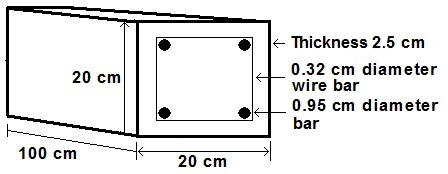
The curing was carried out for 28 days (NOM C-159, ASTM C 192) and subsequently, the specimens were exposed to two different conditions: outdoors (ATM) and immersion in natural sea water (INM), in the southeast of Mexico (San Francisco de Campeche, Campeche, Mexico at 300 meters of the coastline). The structures exposed to the ATM were placed vertically on a concrete base 30 cm above the ground. The specimens exposed in INM were placed in small pools and the natural seawater was changed monthly.
Measurement of Corrosion Potential
The corrosion potential measurement was made according to the ASTM C876 standard. Figure 2a shows the way in which the corrosion potential in the structures exposed to the ATM was measured, taken from five points of the specimens at different heights of the concrete surface, using a saturated copper/copper-sulphate reference electrode, (Cu/CuSO4sat). The measurement of the corrosion potential in the specimens exposed in INM was made using a silver-saturated silver chloride reference electrode (Ag/AgClsat) immersed in the seawater on one side of the sample, see Figure 2b.
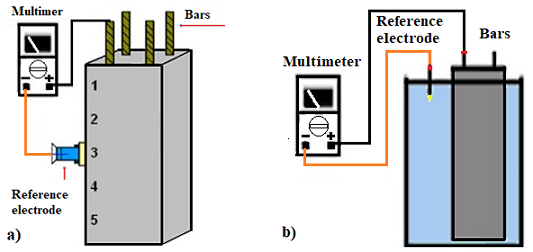
Table 2 presents the proposed criteria to analyze the corrosion potentials of reinforcing steel (Ecorr) embedded in concrete. The analysis of corrosion potentials will be focused on the saturated silver-silver chloride reference electrode (Ag/AgClsat); therefore, the conversion of corrosion potentials obtained with the saturated copper-copper sulfate reference electrode is equal to +50 mV (Berkeley, 1990; Chess, 1998).
| Ecorr vs Cu/CuSO4(sat) (mV) | Ecorr vs Ag/AgCl(sat) (mV) | Corrosion Probability (%) |
| Greater than -200 | Greater than -150 | 10% (Passive zone) |
| Between -200 and -350 | Between -150 and -300 | 50% (Uncertain zone) |
| Less than -350 | Less than -300 | 90% (Active zone) |
For this test three cores of each series were extracted by using a core extractor, see Figure 3a (ASTM C42/C42M). This procedure was performed in 4 periods of six months each (6, 12, 18, 24). The cores were removed in the middle part and parallel to the reinforcing steel, see Figure 3a.
The carbonation front was measured using acid-base indicators. Phenolphthalein is the commonly used indicator and its range of color change is between pH 8.2 and 9.8 varying its hue from colorless to reddish violet. Thymolphthalein is another indicator used because its range shift is between pH 9.3 and 10.5 with blue hue to colorless (Troconis Rincón et al, 1997; Standard UNE-112-011). In this way it is possible to observe the pH change of the concrete paste and determine the advance of the carbonation front.
The acid-base indicators were applied up to 1 cm below the level of the reinforcing steel in equal parts, see Figure 3b. A photographic record of the advance of carbonation measured by a rule was taken. Concrete of good quality has a characteristic color of the indicator used and a carbonated concrete has no color. It is due to the decrease of pH resulted from the reaction of carbon dioxide (CO2) with the alkaline components of concrete.
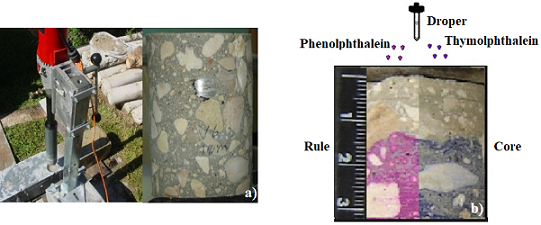
The results present the average advance of the carbonation front of the cores extracted to determine visually and graphically the damage that the exposure medium generated in the concrete and consequently the probability that corrosion of the reinforcing steel could occur.
RESULTS
Carbonation Front
Figures 4 and 5 show the photographic record of the carbonation velocity in the cores of concrete obtained from specimens made without (0%) and with 3.5% by weight of sodium chloride (NaCl) added in the mixing water during two years of exposure to ATM and INM, respectively.
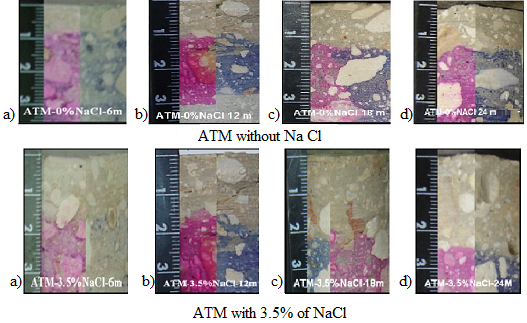
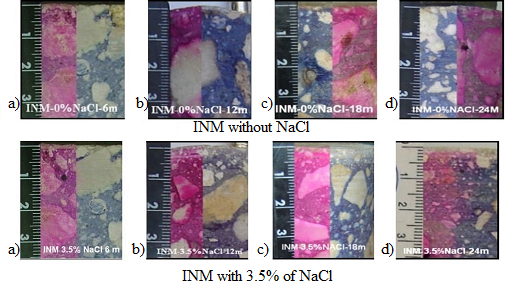
The photographic record of the structures exposed to the ATM, in Figure 4, shows that those made without additional NaCl present an average progress of 8 mm in depth after 6 months of exposure and a depth of 15 mm after 24 months. The most noticeable effect is on the structures containing additional NaCl in the mixing water that presents a greater advance of carbonation, reaching a depth of 15 mm on average in the first 6 months and 25 mm that on average at 24 months, reaching the level of the concrete cover established for reinforcing steel.
In the case of the structures exposed to INM, Figure 5, an insignificant advance of carbonation is observed on both manufacture conditions manufacture of reinforced concrete, reaching on average approximately 1 mm deep during the 24 months that the study lasted. The results were as expected, due to the low solubility of CO2 in seawater, when the structures were immersed in seawater.
According to the results of the carbonation front, there was only a significant effect in the structures exposed to ATM related to the content of NaCl added in the mixing water that influenced the advance of carbonation in concrete. Table 3 records the three samples average results. As expected, the reaction between CO2 and the alkaline components of the concrete is favored when the ambient concrete is between 50% and 80% of water content in the pores of concrete, which are the optimum conditions for carbonation (Pérez, T. et al, 2006; Corvo, F. et al., 2008). Each experimental condition shows closeness of k values during the period of exposure. It has been reported that the wind pattern in Campeche, due to its geographic position, is predominant from land to sea (Gutiérrez and Winant, 1996) and for this reason it is an atypical tropical marine environment (Pérez, T., 2000).
| Time (year) | Increase in carbonation (mm) | Constant k (mm/year½) | ||
| Without Cl- | With Cl- | Without Cl- | With Cl- | |
| 0.5 | 8 | 15 | 11.3 | 21.2 |
| 1.0 | 10 | 17 | 10.0 | 17.0 |
| 1.5 | 12 | 21 | 9.7 | 17.1 |
| 2.0 | 15 | 25 | 10.6 | 17.6 |
| Average | 10.4 | 18.2 | ||
The major advance of carbonation on structures with addition of NaCl, is related to the fact that the pores of the concrete remained partially saturated for a longer time under conditions that favored the entry of CO2. Consequently, the reaction with the components of concrete increased; thus, accelerating the advance of carbonation (Trocónis de Rincón et al, 1997). This proposal is consistent due to the relative humidity (RH) that prevails in the region; approximately 70% annual average, and mainly due to the hygroscopic property of NaCl that favors the preservation of internal humidity. Together they favored the conditions to accelerate the carbonation progress, as was observed in the structures exposed to the ATM with additional NaCl in the mixing water (Pérez et al, 2010).
The advance of carbonation in the structures without additional NaCl, even though at two years did not reach the level of steel, its constant on average of 10.4 mm/year½ is significant because these values are more similar to those reported in urban environments (Moreno, et al., 2004). The novelty of these results in a marine/tropical environment is related to a greater amount of pores due to the water/cement ratio of 0.66 used to manufacture them. Under such conditions the advance of carbonation will depend on the relative humidity of the medium and the necessary time it remains inside the concrete for the reaction of CO2 with the alkaline components of the concrete to take place. It is proposed that the hygroscopic characteristics of NaCl favor the retention of water in the pores of concrete, maintaining the humidity conditions propitious for the carbonation of concrete.
Corrosion potential (Ecorr)
Figure 6 shows the average Ecorr results of reinforcing steel in concrete structures made without (0%) and with 3.5% by weight of sodium chloride (NaCl) added in the mixing water during 2 years of exposure to the ATM and INM.
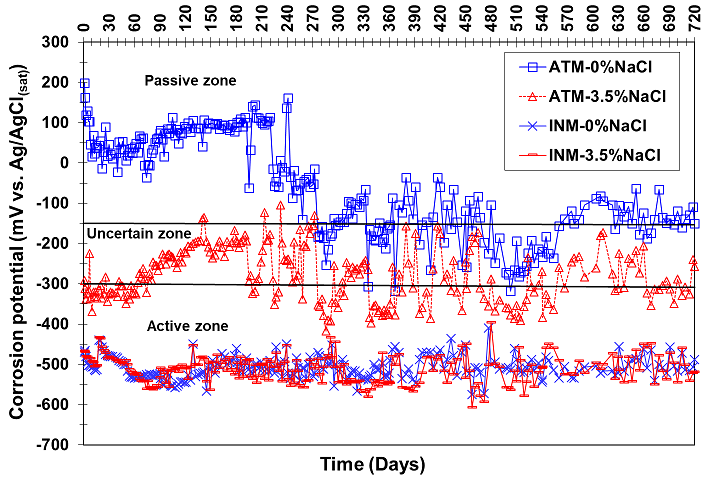
Atmospheric exposure.
The corrosion potentials of the structures prepared without additional NaCl exposed to the ATM (ATM-0% NaCl), according to the criterion of Table 2, showed a passive behavior until day 270; later the potentials became more negative with variations between the passive and uncertain zone. Such behavior that prevailed until the end of the experiment. In the case of those samples made with additional NaCl exposed to the same condition (ATM-3.5% NaCl), the reinforcing steel started with a high probability of corrosion of the steel (active zone) during the first 40 days. reducing its activity and remaining within the uncertain zone approximately until day 200 and later presenting a variable behavior until the end of the study, between the active and uncertain zones. The Ecorr instability is due to variations in meteorological conditions such as temperature and relative humidity, as well as the rainy season.
In samples of reinforced concrete exposed to the ATM the effect of carbonation was ruled out, although the series with additional NaCl, did reach the steel level after 24 months. It is notable that the effect is mainly attributed to the action of chlorides, which modify the conditions of the concrete-reinforcing steel interplay causing a polarization which displaces the Ecorr measures to more negative values. Otherwise, when the presence of corrosive agents is discarded, whether it is an attack by CO2, chlorides or both, as in the series without the addition of the activity, it is not attributed to the onset of corrosion but to the partial saturation of water in the pores of the concrete. Due to the characteristic conditions of the region when being in a tropical environment, where the relative humidity prevailing on average is 65% - 80% (Pérez et al, 2010). In addition, the fact that the carbonation reaction requires water to take place, partially influenced the progress of carbonation in the concrete of each series. Another aspect to be considered is the chemical characteristic of the concrete that surrounds the reinforcing steel, which at the beginning of the study is the first resistance against the agents that cause steel corrosion. As it is observed, the samples without NaCl addition are passive and those manufactured with additional NaCl have potentials with a high probability of corrosion.
Immersion exposure.
Regarding the structures exposed to INM, both series, without and with 3.5% NaCl (INM-0% NaCl and INM-3.5% NaCl), remained within the range between -400 and -500 mV vs electrode Ag/AgCl that corresponds to a behavior of high probability of corrosion of reinforcement steel (active zone), during the 720 days of exposure that lasted the experiment. These values belong to the area of active corrosion that indicates a high probability of corrosion in the reinforcing steel. This behavior is due to the polarization induced by the lack of oxygen in the concrete-rod interface that produces the displacement of Ecorr to more negative values (Ávila, et al., 1994). This condition predominates over the presence of chloride in the water used for the mixture. In the case of the series exposed to INM, the attack by carbonation is practically null, leaving as the main cause of corrosion the chlorides present in seawater and the addition in the mixing water. In this sense, both series presented the same electrochemical behavior with a high probability of corrosion. Under such conditions, it is also necessary to take into account that steel under immersion is exposed to a medium poor in oxygen which makes the potentials more negative similar to those reported.
Photographic record
Figures 7 and 8 show the photographic record of the visual inspection of the concrete-reinforcing steel interface in concrete specimens made without (0%) and with 3.5% by weight of NaCl added in the mixing water, for 2 years of exposure to ATM and INM.
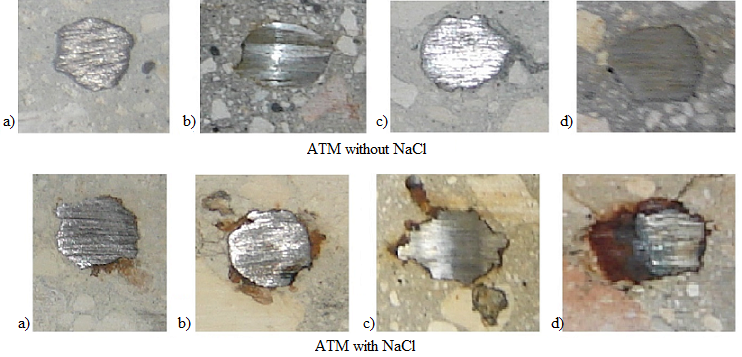
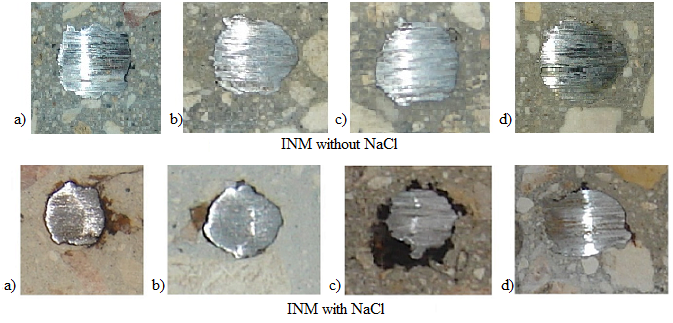
Atmospheric Exposure.
The structures manufactured without additional NaCl exposed to the ATM, Figure 7, do not show corrosion products on the concrete-reinforcing steel interface on any of the four periods. When comparing these results with the structures with 3.5% of additional NaCl, corrosion products are observed on the concrete-reinforcing steel interface after the first 6 months and similarly within the three subsequent periods until the end of the 24-month experiment.
The absence of corrosion products in the structures without additional NaCl, exposed to the ATM, agrees with the electrochemical behavior of steel passivity reported in the corrosion potentials during the first 270 days. However, it subsequently passes to uncertain potentials of corrosion, behavior possibly related to the variation of environmental parameters. When the action of CO2 is ruled out as well as the presence of chlorides at the level of the rod, the uncertain potentials are attributed to variations in environmental conditions, since no corrosion products were observed during the 2 years that the study lasted. Therefore, this behavior is attributed to the relative humidity, rainfall and temperature prevailing in the southeast of Mexico, which favors and gives the conditions to take the steel to potentials at uncertain values (Pérez et al, 2010).
The presence of corrosion products in the samples elaborated with additional NaCl, exposed to the ATM, is attributed mainly to the chlorides present since the beginning of the study, when the effect of carbonation was ruled out, since this reached the level of the rod until 2 years after the study started. These results agree with the corrosion potentials, however, with the photographic record it is not feasible to know precisely the corrosion start time. The Ecorr that indicates a high probability of corrosion during the first 90 days evidence the attack of chloride ions to the steel. In this sense we must take into account that the newly manufactured concrete has the chemical property that protects the steel against corrosion. However, under exposure conditions, steel managed to reduce its activity, remaining within corrosion potentials of the uncertain zone, up to 210 days. Therefore, the corrosion activity decreases, with less negative Ecorr values within the uncertain zone. The competition of passivation-depassivation reactions in the interface is the evidence (Pérez, 2000). In this case, an effect similar to that reported from the samples without additional NaCl was observed, approximately at 210 days of exposure, where the competition between the attack by the chlorides and the chemical protection of the concrete try to maintain the passive layer on the steel. This is attributed to the fact that corrosion potentials fluctuate between the uncertain zone and the active zone, maintaining this behavior until the end of the study. In this sense, under the presented conditions the uncertain values obtained are related to the attack of chlorides to break the passive film and continue the corrosion of the steel.
Immersion exposure.
On those exposed to INM, Figure 8, the structures without additional NaCl do not show significant corrosion product formation on the concrete-reinforcing steel interface in the four periods; while in the structures with 3.5% NaCl added in the mixing water, oxidation is detected from six months after the start of the experiment. However, corrosion is not complete on the interface, since not all the area presents corrosion products. It is proposed that the damage to the film be limited due to the lack of oxygen when immersed in seawater. So, the chloride ion is the cause of corrosion.
In the samples prepared with additional NaCl exposed to INM, the presence of oxides in the concrete-reinforcing steel interface during the four stages of the photographic record coincides with the results of corrosion potentials with high probability of corrosion obtained in the 2 years of study. This is mainly attributed to the chlorides added to the mixing water since the the manufacture of concrete structures, when CO2 was ruled out. The presence of the aggressive agent is the triggering factor for corrosion in reinforcing steel when the conditions are favorable, as in this case and the one observed in the samples with additional NaCl exposed to the ATM. The opposite was observed on the samples without additional NaCl exposed to the ATM and INM where the action of CO2 and chlorides at the rod level were discarded, leaving only the environmental conditions characteristic of the Southeast Mexico and the sea water as the only influences of the electrochemical behavior. In this sense, it is important to determine the presence of the corrosive agent in order to understand and interpret the corrosion potentials, as observed in the samples prepared without and with additional NaCl. Knowing the presence of the corrosive agent and also the significant presence of water is important and necessary element to carry out the chemical reactions of degradation of concrete and consequently the corrosion of reinforcing steel.
In general, the Ecorr measures agree with the photographic record after 6 months. Potentials alone do not provide information on when steel corrosion could have started significantly, as was observed on samples exposed to ATM with 3.5% NaCl. Corrosion is only inevitable when chlorides are already present at the level of reinforcing steel.
Figure 9 exemplifies the damage found on the specimens. On those exposed to ATM, carbonation leads to a decreasing pH of the material, although not enough to activate the steel. The same process is observed on prepared without and with NaCl. Meanwhile, the existing chloride ions reach the critical point to initiate the corrosion outbreak, but only on samples prepared with NaCl. On the specimens immersed in seawater, the trigger was the chloride ion, as observed for the existence of oxides since the first exposure period of samples prepared with NaCl. Those not prepared with NaCl did not develop corrosion at the concrete-steel interface.

CONCLUSIONS
Carbonation was not a factor for the development of corrosion in samples of reinforced concrete exposed to atmospheric conditions or in immersion. Only the samples prepared with additional NaCl in the mixing water, exposed to the ATM, reached a depth of 25 mm at the level of the rod 2 years after the study started. As for samples without additional NaCl, the advance of carbonation was lower, with an average depth of 15 mm at the end of the study.
The addition of NaCl in the mixing water and the characteristic environment in southeastern Mexico favored the advance of carbonation on samples exposed to the weather, reaching the steel level in two years of study; dissimilar to the structures without additional NaCl. This is due to the hygroscopic properties of NaCl, which together with the relative humidity prevailing in the tropical marine environment, maintain a longer moisture in the pores of the concrete which is conductive to carbonation reactions with the alkaline components of the concrete.
In the samples without additional NaCl, exposed to ATM and INM, no corrosion products were observed on the concrete and steel interface, which evidences that chloride ions are the determining factor to depass the interface.
In the case of samples with additional NaCl, corrosion was observed at the concrete-steel interface, which is in accordance with the corrosion potentials for both environmental conditions. This behavior was mainly attributed to the chlorides already present when the samples were prepared on the steel reinforcement interface of concrete. Therefore, chlorides were the main agent to initiate and develop the corrosion process which was evident for the presence of corrosion products on the concrete-rod interface. The same process was observed on both series of samples made with NaCl in the mixing water.
The visual inspection of the concrete-reinforcing steel interface was decisive to confirm the ranges of values of the steel corrosion potentials according to the variables analyzed.
The results obtained confirm that the corrosion potentials can lead to wrong inferences when the pores are saturated with water. Therefore, if the corrosive agent has reached the level of the rod, it offers greater certainty to determine the probability of corrosion in the reinforcing steel, as observed when comparing the samples prepared without and with additional of NaCl exposed to ATM and INM. This is related to the type of exposure that led potentials to more negative values due to the limited access of oxygen by water saturation, in the pores of the concrete, and not by the corrosion of the steel, as confirmed by the photographic record.
Acknowledgements
The authors thank CONACYT projects CB-2008-01101891 and CB-2002-C01-40484 for partial support.
REFERENCIAS
ASTM International (2002), “ASTM C192/C192M-02 Standard Practice for Making and Curing Concrete Test Specimens in the Laboratory”. Retrieved from https://doi.org/10.1520/C0192_C0192M-02.
ASTM International (2009), “ASTM C876-09 Standard Test Method for Corrosión Potentials of Uncoated Reinforcing Steel in Concrete”. Retrieved from, https://doi.org/10.1520/C0876-09.
ASTM International (2012), “ASTM C42/C42M-12 Standard Test Method for Obtaining and Testing Drilled Cores and Sawed Beams of Concrete”. Retrieved from https://doi.org/10.1520/C0042_C0042M-12.
Ávila-Mendoza, J., M. Flores, J., C. Castillo, U. (1994), “Effect of Superficial Oxides on Corrosion of Steel Reinforcement Embedded in Concrete”, CORROSION, V. 50 pp. 879-885.
Berkeley, K. G., Pathmanaban, S. (1990), “Cathodic protectión of reinforcement steel in concrete”, Ed. Butterworths, United Kingdom, ISBN 0-408-03270-1.
Castro, P., Moreno, E. I. and Genescá, J. (2000a), “Influence of marine micro-climates on carbonatión of reinforced concrete buildings”. Cement and Concrete Research V. 30, pp. 1565-1571, http://dx.doi.org/10.1016/S0008-8846(00)00344-6.
Castro, P., Sanjuan, M. A. and Genesca, J. (2000b), " Carbonatión of concretes in the Mexican Gulf", Building and Environment., V. 35, pp. 145-149, https://doi.org/10.1016/S0360-1323(99)00009-8
Castro-Borges, P., Veleva, L., Balancán-Zapata, M., Mendoza-Rangel, J. M., Juárez-Ruiz, L. A. (2013), “Effect of environmental changes on chemical and electrochemical parameters in reinforced concrete. the case of a tropical marine atmosphere”, International Journal of Electrochemical Science, V. 8, Issue 5, pp. 6204-6211.
Chávez-Ulloa, E., Pérez-López, T., Reyes Trujeque, J., Corvo Pérez, F. (2013), “Deterioro de elementos de concreto en medio ambiente marino tropical y cámara de carbonatación acelerada”, Rev. Téc. Ing. Univ. Zulia, V. 36, pp 104-113.
Chess, P., Gronvold and Karnov, (1998), “Cathodic protectión of steel in concrete”, E&FN Spon, United Kingdom, ISBN 0-419-23010-6.
Corvo, F., Pérez, T., Martin, Y., Reyes, J., Dzib, L. R., González-Sánchez, J., Castañeda, A. (2008), “Time of wetness in tropical climate: Considerations on the estimation of TOW according to ISO 9223 standard”, Corrosion Science, V. 50, pp. 206–219.
Genescá, J. (1994). Más allá de la Herrumbre III: Corrosión y medio ambiente. 1ra Edición. Fondo de Cultura Económica. México, D.F.
Gutiérrez, G. and Winant, C. D. (1996)" Seasonal patterns of winds stress and wind stress curl over the Gulf of Mexico". Journal of Geophysical Research, Vol. 101, No. 8, pp. 127.
Helene, P., Castro-Borges, P. (2009), “A novel method to predict concrete carbonatión”, Concr. Cem. Investig. Desarro. V. 1, No. 1, pp. 25-35.
Melchers, R. E., Li, C. Q. (2009), “Reinforcement corrosión initiatión and activatión times in concrete structures exposed to severe marine environments”, Cement and Concrete Research, V. 39, issue 11, 1068, http://dx.doi.org/10.1016/j.cemconres.2009.07.003.
Moreno, E. I., Domínguez Lara, G. G., Cob Sarabia, E. J., Duarte Gómez, F. (2004), “Efecto de la relación agua/cemento en la velocidad de carbonatación del concreto utilizando una cámara de aceleración Ingeniería”, Ingeniería, V. 8, No. 2, pp. 117-130.
NMX-C-495-ONNCCE-2015 (2015), "Industria de la construcción – Durabilidad de estructuras de concreto reforzado – Medición de potenciales de corrosión del acero de refuerzo sin revestir, embebido en concreto – Especificaciones y método de ensayo”
NOM C-159-85 (1985), “Concreto Elaboración y Curado en Laboratorio de Especímenes”.
Papadakis, V. G., Vayenas, C. G., Fardis, M. N. (1991a), “Fundamental modeling and experimental investigatión of concrete carbonation”. ACI Materials Journal, V. 88, No. 4, pp. 363-373.
Papadakis, V. G., Vayenas, C. G., Fardis, M. N. (1991b), “Physical and chemical characteristics affecting the durability of concrete”, ACI Materials Journal., V. 88, No. 2, pp. 186-196.
Pérez, T., Castro, P., Genescá, J. (2006), “Influence of meteorological parameters over the chloride ingress to concrete exposed to marine environment”. II Congreso Nacional ALCONPAT México 2006, 8 y 9 de Noviembre de 2006, Tampico, Tamaulipas, México ISBN 968 – 9031 -14 – 7.
Pérez, T. (2000), “Kinetics study of the concrete steel embedded reinforcement subject to different exposure conditións at marine environment”, PhD thesis, UNAM, México.
Pérez, T., Sosa, M. R., Dzib, L. R., Reyes, J., Camacho, R., Troconis-Rincon, O. y Torres-Acosta, A. (2010), “Reinforced concrete beams deterioratión in tropical marine environment: DURACON-Campeche”. Concrete Under Severe conditións – Castro Borges et al (eds), Editorial Taylor & Francis Grup, London, pp. 413-420, ISBN: 978-0-415-59316-B.
Rosas, O., Maya-Visuet, E., Castaneda, O. (2014), “Effect of chloride ións on the electrochemical performance of LDX 2003 alloy in concrete and simulated concrete-pore solutions”, J. Appl. Electrochem., V. 44, issue 5, pp. 631-646, DOI: http://dx.doi.org/10.1007/s10800-014-0668-0.
San Miguel, G. F., Tamez, P. V., Alvarado, M. R., Alcorta, R. G., Garza, R. M., Farias, J. P. (2012), Deterioro por corrosión de elementos de concreto armado de un edificio industrial. Revista ALCONPAT, V. 2, No., 3, pp. 195 – 210. DOI: http://dx.doi.org/10.21041/ra.v2i3.38.
Solís Carcaño, R. G., Moreno, E. I., Castro Borges, P. (2005), “Durabilidad en la estructura de concreto de vivienda en zona costera. Ingeniería”, Ingeniería, V. 9, pp. 13-18.
Trocónis de Rincón, O. (1997), Manual for inspecting, evaluating and diagnosing corrosión in reinforced concrete structures. DURAR Network Members. CYTED. ISBN 980-296-541-3, Maracaibo, Venezuela. 1997/1998/2001 (1st ed. 2nd ed. and 3rd ed. in Spanish), 2000 (1st ed. in English).
Trocónis de Rincón, O., Sánchez, M., Millano, V., Fernández, R., de Partidas, E. A., Andrade, C., Martínez, M., Castellote, M., Barboza, F., Irassar, J. C., Montenegro, R., Vera, A. M., Carvajal, R. M., de Gutiérrez, I., Maldonado, J., Guerrero, C., Saborio-Leiva, E., Villalobos, A. C., Tres-Calvo, G., Torres-Acosta, A., Pérez-Quiroz, J., Martínez-Madrid, M., Almeraya-Calderón, F., Castro-Borges, P., Moreno, E. I., Pérez-López, T., Salta, M., de Melo, A. P., Rodríguez, G., Pedrón, M., Derrégibus, M. (2007) “Effect of the marine environment on reinforced concrete durability in Iberoamerican countries: DURACON project/CYTED”, Corrosion Science, V. 49, Issue 7, pp. 2832-2843.
UNE-112-011 (1994), Corrosión en armaduras. Determinación de la profundidad de carbonatación en hormigones endurecidos y puestos en servicio., Madrid, Ed. AENOR.
Ye, H., Jin, N., Jin, X. and Fu, C. (2012), “Model of chloride penetratión into cracked concrete subject to drying–wetting cycles”, Construction and Building Materials, V. 36, pp. 259-269.
Zitrou, E., Nikolaou, J., Tsakiridis, P. E. and Papadimitriou, G. D. (2007), “Atmospheric corrosión of steel reinforcing bars produced by various manufacturing processes”, Construction and Building Materials, V. 21, Issue 6, 1161-1169, http://dx.doi.org/10.1016/j.conbuildmat.2006.06.004.
Ávila-Mendoza, J., M. Flores, J., C. Castillo, U. (1994), “Effect of Superficial Oxides on Corrosion of Steel Reinforcement Embedded in Concrete”, CORROSION, V. 50 pp. 879-885.
Author notes
tezperez@uacam.mx
Additional information
Cite as:: M. R. Sosa, T.
Pérez, V. M. J. Moo-Yam, E. Chávez, J. T. Pérez-Quiroz (2018), “Analysis of the concrete-steel interface
in specimens exposed to the weather and immersed in natural sea water”,
Revista ALCONPAT, 8 (1), pp. 16 – 29. DOI: 10.21041/ra.v8i1.203
Legal Information: Revista ALCONPAT is a quarterly publication of
the Latinamerican Association of quality control, pathology and recovery of
construction- International, A. C., Km. 6, antigua carretera a Progreso,
Mérida, Yucatán, C.P. 97310, Tel.5219997385893, alconpat.int@gmail.com , Website: www.alconpat.org
Editor: Dr. Pedro Castro Borges. Reservation of rights to exclusive
use No.04-2013-011717330300-203, eISSN 2007-6835, both awarded by the National
Institute of Copyright. Responsible for the latest update on this number,
ALCONPAT Informatics Unit, Ing. Elizabeth Sabido Maldonado, Km. 6, antigua
carretera a Progreso, Mérida, Yucatán, C.P. 97310.
The views expressed by the authors do not
necessarily reflect the views of the publisher.
The total or partial reproduction of the
contents and images of the publication without prior permission from ALCONPAT
International A.C. is not allowed.
Any discussion, including authors reply, will be
published on the third number of 2018 if received before closing the second
number of 2018.